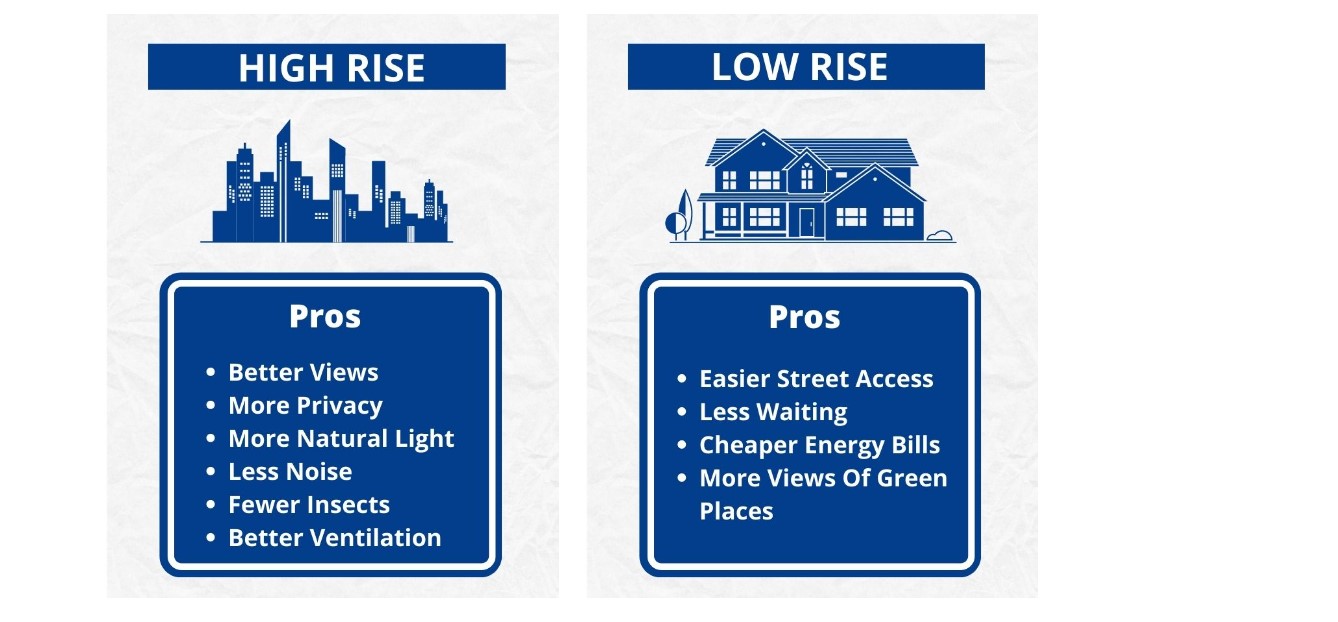Low Rise Apartments vs High Rise Apartments
Deal Acres
Last Update 2 years ago
Vertical expansion in Indian real estate has been made possible by the country’s expanding population and limited availability of land. As a result, many areas of the country have residential structures with up to 100 floors, conveniently making them skyscrapers. Even though many people find the concept of living on higher floors appealing, some who like to be closer to the ground may not find it appealing.
Low Rise Apartments vs High Rise Apartments

While high rises have many stories that can house apartments, low-rise structures typically have four floors or less. Each floor of low-rise builder floor flats provides a single residence.
You can frequently have to choose between purchasing a unit on a lower or higher floor while purchasing an apartment. This choice frequently also depends on the city in question. For instance, living on a lower floor may be favored in Delhi NCR due to the convenience of utilities, whereas upper floors may be chosen in metropolitan due to the views they provide. Both options offer advantages and disadvantages, so you should carefully consider all the options before making a decision.
Pros
A Low rise building floor provides unmatched independence. These frequently serve affluent clients who like spending more money on superior amenities and privacy. Low Rise structures provide a few benefits, including:
- Elevators don’t require to be installed or used on lower floors.
- In comparison to High Rise structures, Low Rise buildings have reduced maintenance and energy expenditures.
- Low Rise structures make it simpler to adhere to fire safety regulations. In these structures, emergency evacuation is also simpler.
- Low Rise constructions are more luxurious and have a better resale value than High Rise ones.
- Because there are fewer floors, it is simpler to reach the street and the nearby amenities, including shops, parks, and ATMs.
- The owner would be better able to utilize the advantages of the garden area by being closer to the ground.
Cons
The following are some drawbacks of choosing a Low rise apartment:
- Homes on the ground floor or the first floor offer several entry points for thieves, risking the security of the occupants.
- In the event of flooding, a Low rise flat is vulnerable to damage.
- A good view is more difficult to obtain from lower floors, which is unimportant in High Rise buildings.
High Rise Apartments

Young homebuyers who are looking to purchase an affordable flat on the upper floors are particularly drawn to High Rise apartments. Urban planners are preparing themselves to accommodate the most families possible in an era of severe space shortage as a result of the inflow of people into metro areas in quest of better living and employment conditions.
Pros
Owning a residence in a complex of High rise apartments has some benefits, including:
- Homes at high altitudes provide a quiet environment, cleaner air, greater ventilation, and beautiful views. The apartments also have lots of natural light.
- On the upper floors, there is a great deal of privacy, which is frequently lacking on the lower ones.
- Compared to ground-level structures, High Rise buildings frequently include well-thought-out security systems. Intruders also have limited access to floors that are higher up.
- Anyone can dread having to climb stairs that are five or more stories high. However, elevators are available on every High Rise, making it simple to access the upper floors.
- Homebuyers typically have more housing options due to the higher density of High rise buildings than Low rise buildings.
Cons
The disadvantages of a high-rise apartment include: It is more challenging to leave in an emergency, such a fire, the higher the level. If there are disabled family members, it becomes even more difficult.
- A high-rise building’s typical construction cost per square foot is 20–25 percent greater than that of a Low Rise building, making them a more expensive investment than the latter.
- A high-rise building’s exterior cleaning and maintenance can be very expensive and risky.
- Taller structures are more likely to sustain damage during earthquakes.
Which Floor Should You Live On?
There is a significant caveat to the advantages and disadvantages listed above. Depending on the floor you’re on, several benefits and drawbacks of a High rise apartment can differ.
For instance, having access to the street from a high-first-rise floor is just as good as having it from, if not better than, a low-third-rise floor. On the other hand, the first-floor flat won’t offer the excellent views that are typically seen in taller buildings. You might actually enjoy more privacy, less noise, and cleaner air on a higher floor, like the 25th, than the bottom floor on a Low Rise.

We can’t assure you which is a better type of apartment is “better,” High Rise or Low Rise. In terms of your needs, we may assume that one will be superior to the other. We hope that this article and other ones on our website have addressed every concern you might have had while making this choice. Gratitude for reading!

